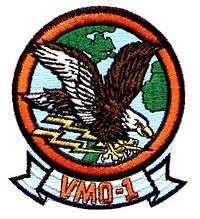VMO-1
- For the earlier VMO-1 which formed in MCB Quantico in 1937 see VMTB-151
| Marine Observation Squadron 1 | |
|---|---|
|
VMO-1 insignia | |
| Active | July 27, 1943 – July 31, 1993 |
| Country | United States |
| Branch | USMC |
| Type | Observation |
| Role |
Artillery spotting Aerial reconnaissance |
| Garrison/HQ | Inactive |
| Nickname(s) | Yazoo |
| Motto(s) | “Can Do” |
| Tail Code | ER |
| Engagements |
World War II * Battle of Guam * Battle of Iwo Jima Operation Desert Storm |
Marine Observation Squadron 1 (VMO-1) was an observation squadron of the United States Marine Corps which saw extensive action during World War II and supported numerous contingencies during the Cold War. They were based at Marine Corps Air Station New River, North Carolina and saw their final deployment in support of Operation Desert Storm in 1991. They were deactivated on July 31, 1993.
History
World War II
Marine Observation Squadron 155 (VMO-155) was formed at Marine Corps Air Station Quantico, Virginia on July 27, 1943. In November of that year they moved out to San Diego, California and on January 1, 1944, they were redesignated Marine Observation Squadron 1 (VMO-1) and deployed to Espiritu Santo. In February 1944, they moved to Guadalcanal and in July they joined the III Amphibious Corps and participated in the Battle of Guam. In February and March 1945, the squadron also participated in the Battle of Iwo Jima.
1946–1980s

In January 1946, the squadron moved to Marine Corps Air Station Cherry Point. During the Korean War, they trained replacement pilots for the war and supported operation of the 2nd Marine Division. In 1952, they moved to Marine Corps Air Station New River and received their first helicopters. In 1958, the squadron was part of the U.S. 6th Fleet task force that intervened in Lebanon and in 1965 they participated in the U.S. intervention into the Dominican Republic.
In July 1968, VMO-1 became conversion to the OV-10 Bronco and by 1971 they were an all fixed-wing squadron. During the 1970s and 1980s, the squadron rotated through deployments to Japan and supported exercises throughout Asia, the Mediterranean, the Caribbean and Northern Europe.
1990s and deactivation
In December 1990, the squadron boarded the USS America and USS Theodore Roosevelt headed for Saudi Arabia to support Operation Desert Shield. When Operation Desert Storm began, the squadron flew over 1000 combat sorties with the loss of 1 aircraft and 1 pilot killed in action. Upon their return, the squadron was deactivated on July 31, 1993.
Unit awards
| Navy Unit Commendation (with one bronze star) | |
| Meritorious Unit Commendation | |
| Asiatic-Pacific Campaign Medal | |
| World War II Victory Medal | |
| National Defense Service Medal (with two bronze stars) | |
| Armed Forces Expeditionary Medal | |
| Southwest Asia Service Medal (with two bronze stars) |
See also
- United States Marine Corps Aviation
- List of active United States Marine Corps aircraft squadrons
- List of inactive United States Marine Corps aircraft squadrons
Notes
References
- Bibliography
- Web

